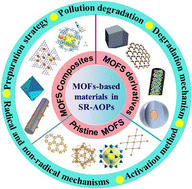Research progress of metal–organic framework-based material activation of persulfate to degrade organic pollutants in water
Abstract
The rapid development of industry in recent years has led to the introduction of serious pollutants into water bodies, and there is an urgent need for efficient organic degradation technologies. At present, selective peroxynitrite (PS) oxidation (SR-AOPs) is an effective way to treat pollutants in water bodies, and it is necessary to select a suitable material for the activation of peroxynitrite. Metal–organic frameworks (MOFs), with their tunable structure, large specific surface area, and tunable ligand molecules exhibit excellent reactivity and catalytic performance in the activation of persulfate. With MOF-based materials for PS activation as a novel advanced oxidation technology, this study reviews MOFs and their composites and derived materials. The current research status of activated persulfate for the treatment of organic pollutants in water, the influence of different systems on the degradation performance are discussed, and the activation and degradation mechanisms are discussed; the problems of the above materials in the degradation of organic pollutants are summarized, and research directions based on the coupled activated persulfate system of MOF materials are proposed.

- This article is part of the themed collection: 2023 Reviews in RSC Advances


 Please wait while we load your content...
Please wait while we load your content...